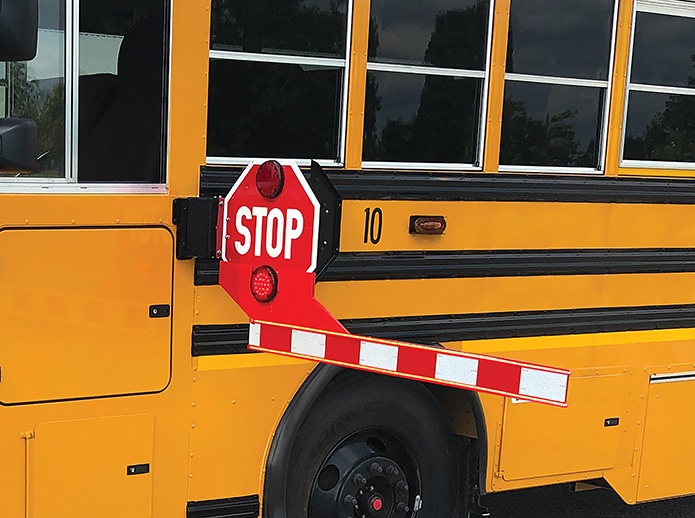
After successfully leading a lobbying effort to allow pilot programs in Illinois, the creators of BusGates say districts nationwide can save lives with stop-arm fixed extenders
 In 2015, after working for many years at the Illinois Department of Transportation (IDOT), Daniel Thompson said he saw a desperate need for increased stop-arm safety.
In 2015, after working for many years at the Illinois Department of Transportation (IDOT), Daniel Thompson said he saw a desperate need for increased stop-arm safety.
“Riding the school bus is incredibly safe – easily the safest way for kids to get to and from school,” he said. “But until we can completely eliminate all school bus related fatalities, we must continue to innovate.”
Citing the national average of nearly 15 children killed each year – as well as the National Association of State Directors of Pupil Transportation Services’ (NASDPTS) 2019 survey which indicated that more than 17 million stop-arm violations occur in America each year – Thompson said he believes the answer lies in preventive technology.
Thompson said he was skeptical of the proactive benefits from stop-arm cameras. Districts should do everything in their power to stop violations before they happen, he said, and not just retroactively punish offenders.
“I think cameras are great technology for enforcement, but I am not sure they have been proven to stop offenses,” he said. “We need to stop these incidents before they happen in order to save lives.”
Developing BusGates
Working with longtime friend and business partner Jeff Stauffer, Thompson patented a polycarbon stop-arm extension outfitted with LED lights. The four-foot-long stop-arm attaches to the existing stop sign and extends far into the roadway — visible from about a mile away — to deter increasingly distracted motorists from passing.
“Dan is a very creative guy, and an entrepreneur,” Stauffer said. “He is really good at finding problems and creating resolutions. I saw his passion and wanted to be a part of developing this innovation, partly due to my wife being a teacher and our own passion for child safety.”
Thompson used his firsthand knowledge of the school bus industry when developing the stop-arm extension, and said he wanted the resulting product to be feasible for as many districts as possible. As such, he designed the system with easy installation, long life, and a low price point in mind.

At $400 per unit, Thompson wanted districts to outfit entire fleets without being financially hamstrung. Sometimes, this means that BusGates works with districts to create payment plans and lease-to-own deals. Thompson said he would rather have entire district fleets outfitted at lower costs, versus only allowing districts to equip one or two vehicles.
“Many districts and contractors are working with limited funds and limited mechanics,” he said. “The low price was important to us, but so was the installation process. I built the extension so that it does not change the school bus’s structural integrity. Once you compromise the side of a bus with too many screws, it creates a crumple zone in the effect of a side-impact.”
The polycarbon extension attaches to a stop sign with three screws before plugging into the vehicle’s power source. Each system takes about 15 minutes to install.
“The polycarbon design is very important to the system’s useable life,” Thompson said. “If a car does hit the arm, its flexibility means it will not fly off and cause serious damage. The composition means it does not rust or fade, whether in the hot weather of Phoenix or the chills of Canada.”
Illinois HB2584
The big challenge, Thompson said, is that although BusGates technology is federally approved to be on every bus in the U.S. (through the Federal Motor Vehicle Safety Standards [FMVSS] 49 CFR 571.131), most states have their own regulations, and most districts have their own equipment procurement processes.
After developing, patenting, and bringing BusGates to market, Thompson said he began reaching out to his Illinois legislative contacts in 2019, with the goal of jumpstarting a pilot program for stop-arm extension technology. Thompson approached Illinois State Representative Mike Murphy, a longtime acquaintance of Stauffer.
“I spoke to Representative Murphy and explained why I was passionate about curbing stop-arm violations,” Thompson said. “I explained why I thought it was a win-win proposition for children, districts, parents, and elected officials.”

“My first reaction was surprise that districts were not already empowered to do this,” Murphy said. “Regulations on school bus equipment are important, but in this case the benefits were so obvious. We needed to get it done to increase visibility of kids near the bus. It was a no-brainer.”
Murphy introduced legislation in 2019 which ran into some roadblocks, with IDOT expressing concern about whether the bill’s language would interfere with federal guidelines. Once it was clarified that no such conflict existed, COVID-19 struck in 2020 – and most legislation was shelved until the next session.
In the interim, Thompson connected with Trevor Clatfelter, mayor of Sherman, Illinois, and a lobbyist in the state. Clatfelter immediately saw the safety value of this technology and told Thompson he was confident he could help Murphy pass the bill.
“It is a great bill,” Clatfelter said. “It is something I am proud of, and I have personally enjoyed lobbying. I put every bit of my heart and effort into this, because I have three young children myself.”
Thus, Murphy introduced Illinois House Bill 2584 (HB2584) this February, proposing an amendment to the Illinois Vehicle Code. Co-sponsored by Representative Jonathan Carroll, HB2584 initially aimed to authorize districts to immediately begin equipping systems like BusGates.
After some debate, legislators introduced an amendment which instead allows IDOT to establish pilot programs to permit testing of safety equipment not otherwise prohibited by state or federal law. Furthermore, the amendment allows IDOT to permit stop-arm extensions without violating existing vehicle width restrictions.
“The pilot program provision is a big step forward,” Thompson said. “Safety laws like this can take a long time to get passed, and this is critical first step to allow Illinois districts the use of systems like this.”
Murphy added that it is important to note that this is not an unfunded mandate. The new law will simply allow districts to initiate pilot programs for onboard safety technology without running afoul of governing IDOT guidelines or restrictions.
With the help of Murphy and Clatfelter the bill sailed through the House committees before passing unanimously. Senators Chapin Rose and Laura M. Murphy sponsored the bill when it moved to the Illinois State Senate. On May 27, the bill passed both houses with unanimous support. It was sent to Illinois Governor J.B. Pritzker in late June, and at press time HB2584 is soon expected to be signed into law.
“This was a difficult year to lobby the Illinois legislature,” Clatfelter said. “Because of COVID restrictions, we effectively had to lobby with phone calls, text messages, and emails. It can be tough without face-to-face contact, but we were still successful thanks to the strength of the bill. In a normal year, I am confident that this bill would have as many co-sponsors as it did Yes votes.”
Making a Safety Difference
For Clatfelter, the effects of the pending legislation are already apparent. At a recent gathering of friends, Clatfelter spoke with a resident of Sherman who disclosed that in his childhood he was once the recipient of a heart transplant. Clatfelter said he was amazed to hear that, when this resident was eight years old, he received a heart donation from a young girl struck and killed outside of her school bus.
“It was amazing to hear, but sobering,” Clatfelter said. “This resident is a medical marvel, but unfortunately that little girl died because someone drove around her bus when it was stopped. She did not get to live out her childhood nor become an adult. Stories like that show us why technology like this is so critical.”
“Parents have so much to worry about today,” Murphy added. “They should not have to worry when putting their child on a school bus. We should take all precautions we can to ensure those kids’ safety, and this law can hopefully eliminate one of the hazards kids face when boarding or exiting a bus.”
Thompson and Stauffer said they are hopeful the Illinois legislation will encourage other states to take similar measures, allowing districts to push new safety technology to save lives.
“It is so exciting to be a part of a difference-making effort,” Stauffer said. “I would love to see arms like this on every school in the United States. It will save kids’ lives.”
Thompson added, based on discussions he had before the pandemic, that many Canadian districts will also opt for stop-arm extension devices once COVID-19 restrictions have fully lifted.
“In my opinion BusGates, or a stop arm extension, will eventually be on every school bus in the United States and beyond into North America,” Thompson said. “I truly think it is the only measure that will deter people from illegally passing buses.”
For more information on BusGates, visit www.BusGates.com or call Dan Thompson at 217-414-3513.


